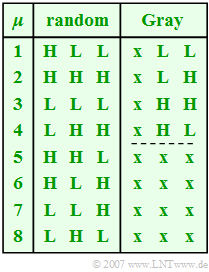Exercise 2.4Z: Error Probabilities for the Octal System
A digital system with $M = 8$ amplitude levels (octal system) is considered, whose $M – 1 = 7$ decision thresholds lie exactly at the respective interval centers.
Each of the equally probable amplitude coefficients $a_{\mu}$ with $1 ≤ \mu ≤ 8$ can be distorted only into the immediate neighbor coefficients $a_{\mu–1}$ and $a_{\mu+1}$, respectively, and in both directions with the same probability $p = 0.01$. Here are some examples:
- $a_5$ passes into coefficient $a_4$ with probability $p = 0.01$ and into coefficient $a_6$ with the same probability $p = 0.01$.
- $a_8$ is distorted with probability $p = 0.01$ into coefficient $a_7$. No distortion is possible in the other direction.
The mapping of each three binary source symbols into an octal amplitude coefficient happens alternatively according to
- the second column in the given table, which was generated "randomly" - without strategy,
- the gray coding, which is only incompletely indicated in column 3 and is still to be supplemented.
The gray code is given for $M = 4$. For $M = 8$ the last two binary characters are to be mirrored at the dashed line. For the first four amplitude coefficients a L is to be added at the first place, for $a_{5}, ..., a_{8}$ the binary symbol H.
For the two mappings "Random" and "Gray" are to be calculated:
- the symbol error probability $p_{\rm S}$, which is the same in both cases; $p_{\rm S}$ indicates the average distortion probability of an amplitude coefficient $a_{\mu}$;
- the bit error probability $p_{\rm B}$ related to the (decoded) binary symbols.
Notes:
- The exercise belongs to the chapter "Basics of Coded Transmission".
- Reference is also made to the chapter "Redundancy-Free Coding" .
Questions
Solution
- "LHH" for the amplitude coefficient $a_{3}$ ⇒ $\underline{\mu =3}$.
- "HLL" for the amplitude coefficient $a_{8}$ ⇒ $\underline{\mu =8}$.
(2) The outer coefficients ($a_{1}$ and $a_{8}$) are each distorted with probability $p = 1 \%$,
the $M – 2 = 6$ inner ones with twice the probability $(2p= 2 \%)$. By averaging, we obtain:
- $$p_{\rm S} = \frac{2 \cdot 1 + 6 \cdot 2} { 8} \cdot p\hspace{0.15cm}\underline { = 1.75 \,\%} \hspace{0.05cm}.$$
(3) Each transmission error (symbol error) results in exactly one bit error in gray code. However, since each octal symbol contains three binary characters, the following applies
- $$p_{\rm B} ={p_{\rm S}}/ { 3}\hspace{0.15cm}\underline { = 0.583 \,\%} \hspace{0.05cm}.$$
(4) Of the total of seven possible transitions (each in both directions) lead to
- one error: HLH $\Leftrightarrow$ LLH,
- two errors: HLL $\Leftrightarrow$ HHH, LLL $\Leftrightarrow$ LHH, HHL $\Leftrightarrow$ HLH, LLH $\Leftrightarrow$ LHL,
- three errors: HHH $\Leftrightarrow$ LLL, LHH $\Leftrightarrow$ HHL.
It follows that:
- $$p_{\rm B} = \frac{p} { 3} \cdot \frac{1 + 4 \cdot 2 + 2 \cdot 3} { 7} = \frac{15} { 21} \cdot p \hspace{0.15cm}\underline { = 0.714 \,\%} \hspace{0.05cm}.$$
